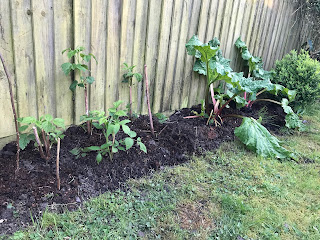What to do with garden waste
I've been making progress in my new garden. These lovely Romanesco courgette seeds were up and germinated within just 3 days. It has been exceptionally warm in the last week here in the South of the UK.
I was out in my front garden doing some work and this blackbird was just so excited, he was hopping between my feet and right under my trowel to get to the creepy crawlies that I was digging up. Top of the menu was some lovely chafer grubs I disturbed.
My new local authorty here is the New Forest district council, and unlike my old home in London they do not take away garden waste along with the household waste. You have to pay for each single garden waste bag (£30 per year) which is collected every 2 weeks. I could fill one of those bags in 5 minutes so I am having to make regular trips to the council dump at the moment. An interesting way of disposing of nasty weeds like dandelion, dock, bindweed is to soak it underwater in a bucket and make a liquid plant feed - just as you would with comfrey or nettles. Make those pesky weeds work in my favour for a change!
Garden waste and lawn clippings which are suitable for composting go in my new bin. Grass on its own must be mixed with brown leaves, twigs and cardboard to make a good healthy mix of nitrogen and carbon.
I brought some Tayberry cuttings from my old garden, they seem to be doing well in their new spot. A Tayberry is a cross between a raspberry and a blackberry. I seem to have a sandy loam soil here in the New Forest, so a good dressing of my horse manure compost was just the ticket.
Meanwhile the tomatoes and chillis are pretty much ready to be planted out. I must be absolutely sure there will be no more frosts before I put them out in their final position. As they say in Scotland (apparently..) "Ne'er cast a clout till May is out" - so there you have it.


















